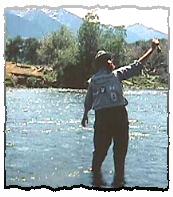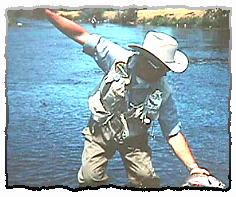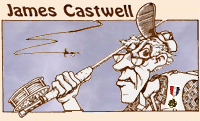|
March 15th, 1999
2000 Ways to Break a Rod
Ok, I lied; this is about just one of the two-thousand.
In time you may find the rest, or invent some new ones. Good luck. There
are two types of fly-fishers reading this. Those of you who have broken a fly
rod, and those of you who have not. The former may actually have broken
several and by usually different means. Sure there is the car door, the trunk
lid, poking it into the ground, ripping a fly out of a tree, stepping on it, stepping
on the leader as you are walking, forgetting it and running over it, backing over
it when you remember you just drove off without it, catching a tree behind you
on the forward cast, lifting far too much front-line from the water on a back-cast,
stringing it up, unstringing it, slapping the water with it to get a tangle off the tip,
setting-the-hook, actually fighting a fish, landing a fish, the dog ate it, and a few
more.
Then there are those of you who are new.
Due to space limitations I will only address the
most common one. Can you guess which one it is? All of the above
are common, well, most are. I have had a chance to discuss the breakage
situation with some rod-makers and they all seem to pretty much agree.
It is NOT the car door. And NOT the trunk lid either. Ripping a fly out
of a tree in front of you does well, but there is one dandy that tops all the
rest. It is when you are landing a fish, no question about it.
Think for a bit on the scene. You are excited, attention
focused on the fish, some concerned if the leader knots will hang in the tip-top,
and anxious to get or release the fish. The rod is now only a tool, a lever, a stick,
something in your casting hand, almost a liability. Perhaps you lay it down, hand
it to a friend, drop it in the boat, either way, it becomes a problem. And that is
when the inevitable happens. To swing the fish closer to you, you point the rod
behind you and are rewarded with one of the most sickening sounds in the
fly-fishing world. A wave of incredulity passes over you. Your mind refuses
to accept the fact that your rod just broke. Emotions take control. Attention
to the fish may wane. The experience is traumatic in the fullest.
And it probably just messed up your fishing day
and cost you more than a few bucks too. So, how to avoid this problem?
Actually it is rather easy. For instance, you are kneeling on a stream-bank
or ocean beach. Rod in the right hand, a nine-foot fly-rod, ten foot leader,
the knot at the tip-top. You point the rod over your right shoulder and
reach for the fish with your left hand. The rod and line are now parallel to
each other. As you reach with the left hand the right raises ever so slightly,
just enough to break the tip. Or, the fish flops and pulls on the leader, same result.
The correction here should have been, to extend your
right arm and lock the right elbow straight. This would mean you may
have had to reel in another foot of line onto the rod, but the rod should
be held AWAY from your body. Way out to the right, or perhaps even
out behind you with the rod partially over your head.


If the fish flops now the rod can flex and if the fish
runs the rod can follow it. Even if your standing in a stream the same will
hold true. This works for large salmon, bone-fish, or trout on a light rod.
I hope you try this at home and practice it. Put the rod together and go out
in the yard and see for yourself. If you do it may drop your odds down to
one in 1999. ~ JC
Till next week, remember ...
|



